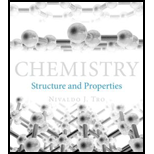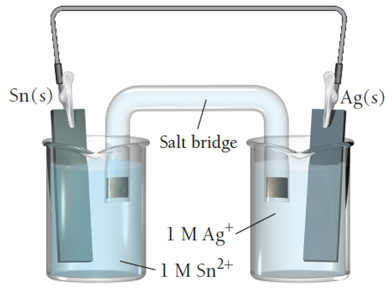
Chemistry: Structure and Properties Plus MasteringChemistry with eText -- Access Card Package
1st Edition
ISBN: 9780321729736
Author: Nivaldo J. Tro
Publisher: PEARSON
expand_more
expand_more
format_list_bulleted
Concept explainers
Textbook Question
Chapter 20, Problem 4SAQ
Refer to Table 19.1 to determine which statement is true of the voltaic cell pictured here.

- Sn is the cathode; Ag is the anode; electrons flow from left to right.
- Sn is the cathode; Ag is the anode; electrons flow from right to left.
- Sn is the anode; Ag is the cathode; electrons How from right to left.
- Sn is the anode; Ag is the cathode; electrons flow from left to right.
Expert Solution & Answer
Want to see the full answer?
Check out a sample textbook solution
Students have asked these similar questions
Questions 4 and 5
For a titration of 40.00 mL of 0.0500 M oxalic acid H2C2O4 with 0.1000 M KOH, calculate the pH at each of the following volume of KOH used in the titration: 1) before the titration begin;2) 15 mL; 3) 20 mL; 4) 25 mL; 5) 40 mL; 6) 50 mL. Ka1 = 5.90×10^-2, Ka2 = 6.50×10^-5 for oxalic acid.
Predict the major organic product(s), if any, of the following reactions. Assume all reagents are in excess unless otherwise indicated.
Chapter 20 Solutions
Chemistry: Structure and Properties Plus MasteringChemistry with eText -- Access Card Package
Ch. 20 - Balance the redox reaction equation (occurring in...Ch. 20 - Prob. 2SAQCh. 20 - Prob. 3SAQCh. 20 - Refer to Table 19.1 to determine which statement...Ch. 20 - Prob. 5SAQCh. 20 - The Zn/Zn2+ electrode has a standard electrode...Ch. 20 - Refer to Table 19.1 to calculate G for the...Ch. 20 - A redox reaction has an Ecell=0.56V . What can you...Ch. 20 - Prob. 9SAQCh. 20 - Prob. 10SAQ
Ch. 20 - Prob. 11SAQCh. 20 - Prob. 12SAQCh. 20 - Which reaction occurs at the cathode of an...Ch. 20 - Copper is plated onto the cathode of an...Ch. 20 - Prob. 15SAQCh. 20 - Prob. 1ECh. 20 - Explain the difference between a voltaic (or...Ch. 20 - Prob. 3ECh. 20 - Prob. 4ECh. 20 - Prob. 5ECh. 20 - Prob. 6ECh. 20 - What is the definition of the standard cell...Ch. 20 - Describe the basic features of a cell diagram (or...Ch. 20 - Why do some electrochemical cells employ inert...Ch. 20 - Describe the standard hydrogen electrode (SHE) and...Ch. 20 - How is the cell potential of an electrochemical...Ch. 20 - Prob. 12ECh. 20 - Prob. 13ECh. 20 - How can Table 19.1be used to predict whether or...Ch. 20 - Explain why Ecell , Grxn , and K are all...Ch. 20 - Does a redox reaction with a small equilibrium...Ch. 20 - How does Ecell depend on the concentrations of the...Ch. 20 - Prob. 18ECh. 20 - What is a concentration electrochemical cell?Ch. 20 - What are the anode and cathode reactions in a...Ch. 20 - What are the anode and cathode reactions in a...Ch. 20 - Prob. 22ECh. 20 - What is a fuel cell? What is the most common type...Ch. 20 - The anode of an electrolytic cell must be...Ch. 20 - What species is oxidized, and what species is...Ch. 20 - If an electrolytic cell contains a mixture of...Ch. 20 - Why does the electrolysis of an aqueous sodium...Ch. 20 - What is overvoltage in an electrochemical cell?...Ch. 20 - How is the amount of current flowing through an...Ch. 20 - Prob. 30ECh. 20 - Prob. 31ECh. 20 - Prob. 32ECh. 20 - Balance each redox reaction occurring in acidic...Ch. 20 - Prob. 34ECh. 20 - Balance each redox reaction occurring in acidic...Ch. 20 - Prob. 36ECh. 20 - Prob. 37ECh. 20 - Balance each redox reaction occurring in basic...Ch. 20 - Prob. 39ECh. 20 - Prob. 40ECh. 20 - Calculate the standard cell potential for each of...Ch. 20 - Prob. 42ECh. 20 - Consider the voltaic cell: Determine the direction...Ch. 20 - Prob. 44ECh. 20 - Use line notation to represent each...Ch. 20 - Use line notation to represent each...Ch. 20 - a sketch of the voltaic cell represented by the...Ch. 20 - Prob. 48ECh. 20 - Determine whether or not each redox reaction...Ch. 20 - Prob. 50ECh. 20 - Which metal could you use to reduce Mn2+ ions but...Ch. 20 - Prob. 52ECh. 20 - Prob. 53ECh. 20 - Prob. 54ECh. 20 - Prob. 55ECh. 20 - Prob. 56ECh. 20 - Calculate Ecell for each balanced redox reaction...Ch. 20 - Prob. 58ECh. 20 - Prob. 59ECh. 20 - Which metal is the best reducing agent? Mn Al Ni...Ch. 20 - Use tabulated electrode potentials to calculate...Ch. 20 - Use tabulated electrode potentials to calculate...Ch. 20 - Prob. 63ECh. 20 - Calculate the equilibrium constant for each of the...Ch. 20 - Calculate the equilibrium constant for the...Ch. 20 - Prob. 66ECh. 20 - Calculate Grxn and Ecell for a redox reaction with...Ch. 20 - Prob. 68ECh. 20 - Prob. 69ECh. 20 - Prob. 70ECh. 20 - Prob. 71ECh. 20 - Prob. 72ECh. 20 - Prob. 73ECh. 20 - Prob. 74ECh. 20 - Prob. 75ECh. 20 - Consider the concentration cell: Label the anode...Ch. 20 - Prob. 77ECh. 20 - Prob. 78ECh. 20 - Prob. 79ECh. 20 - Prob. 80ECh. 20 - Refer to the tabulated values of Gf in Appendix...Ch. 20 - Refer to the tabulated values of Gf in Appendix...Ch. 20 - Prob. 83ECh. 20 - Prob. 84ECh. 20 - Prob. 85ECh. 20 - Prob. 86ECh. 20 - Prob. 87ECh. 20 - Which products are obtained in the electrolysis of...Ch. 20 - Write equations for the half-reactions that occur...Ch. 20 - Which products are obtained in the electrolysis of...Ch. 20 - Prob. 91ECh. 20 - Write equations for the half-reactions that occur...Ch. 20 - Prob. 93ECh. 20 - Prob. 94ECh. 20 - Prob. 95ECh. 20 - Silver can be electroplated at the cathode of an...Ch. 20 - A major source of sodium metal is the electrolysis...Ch. 20 - Prob. 98ECh. 20 - Prob. 99ECh. 20 - Prob. 100ECh. 20 - Consider the molecular view of an AL strip and...Ch. 20 - Consider the molecular view of an electrochemical...Ch. 20 - Prob. 103ECh. 20 - Prob. 104ECh. 20 - The cell potential of this electrochemical cell...Ch. 20 - Prob. 106ECh. 20 - Prob. 107ECh. 20 - What voltage can theoretically be achieved in a...Ch. 20 - A battery relies on the oxidation of magnesium and...Ch. 20 - A rechargeable battery is constructed based on a...Ch. 20 - If a water electrolysis cell operates at a current...Ch. 20 - Prob. 112ECh. 20 - Prob. 113ECh. 20 - Prob. 114ECh. 20 - Calculate Grxn and K for each reaction. The...Ch. 20 - Calculate Grxn and K for each reaction. The...Ch. 20 - The molar mass of a metal (M) is 50.9 g/mol; it...Ch. 20 - A metal forms the fluoride MF3. Electrolysis of...Ch. 20 - A sample of impure tin of mass 0.535 g is...Ch. 20 - Prob. 120ECh. 20 - Prob. 121ECh. 20 - A 215 mL sample of a 0.500 M NaCl solution with an...Ch. 20 - Prob. 123ECh. 20 - Prob. 124ECh. 20 - Prob. 125ECh. 20 - Prob. 126ECh. 20 - Prob. 127ECh. 20 - Prob. 128ECh. 20 - Prob. 129ECh. 20 - Three electrolytic cells are connected in a...Ch. 20 - Prob. 131ECh. 20 - Prob. 132ECh. 20 - Prob. 133ECh. 20 - Prob. 134ECh. 20 - Prob. 135E
Knowledge Booster
Learn more about
Need a deep-dive on the concept behind this application? Look no further. Learn more about this topic, chemistry and related others by exploring similar questions and additional content below.Similar questions
- Predict the major organic product(s), if any, of the following reactions. Assume all reagents are in excess unless otherwise indicated.arrow_forwardHow many signals would you expect to find in the 1 H NMR spectrum of each given compound? Part 1 of 2 2 Part 2 of 2 HO 5 ☑ Х IIIIII***** §arrow_forwardA carbonyl compound has a molecular ion with a m/z of 86. The mass spectra of this compound also has a base peak with a m/z of 57. Draw the correct structure of this molecule. Drawingarrow_forward
- Can you draw this using Lewis dot structures and full structures in the same way they are so that I can better visualize them and then determine resonance?arrow_forwardSynthesize the following compound from cyclohexanol, ethanol, and any other needed reagentsarrow_forwardFor a titration of 20.00 mL of 0.0500 M H2SO4 with 0.100 M KOH, calculate the pH at each of the following volume of KOH used in the titration: 1) before the titration begin; 2) 10.00 mL; 3) 20.00 mL; 4) 30.00 mL. Ka2 = 1.20×10-2 for H2SO4.arrow_forward
- Curved arrows are used to illustrate the flow of electrons. Using the provided starting and product structures, draw the curved electron-pushing arrows for the following reaction or mechanistic step(s) Be sure to account for all bond-breaking and bond-making steps Problem 73 of 10 Drawing Amows ro HO Donearrow_forward12. Synthesize the following target molecules (TMs) using the specified starting materials. .CI a) HO3S SM TM b) HO- SMarrow_forwardFor a titration of 20.00 mL of 0.0500 M H2SO4 with 0.100 M KOH, calculate the pH at each of the following volume of KOH used in the titration: 1) before the titration begin; 2) 10.00 mL; 3) 20.00 mL; 4) 30.00 mL. Ka2 = 1.20×10-2 for H2SO4.arrow_forward
- Write the systematic name of each organic molecule: structure name show work. don't give Ai generated solutionarrow_forwardShow work with explanation needed. Don't give Ai generated solutionarrow_forwardA Elschboard Part of SpeechT-D Alt Leaming App app.aktiv.com Curved arrows are used to illustrate the flow of electrons. Using the provided resonance structures, draw the curved electron- pushing arrows to show the interconversion between resonance hybrid contributors. Be sure to account for all bond-breaking and bond-making steps. Include all lone pairs and formal charges in the structures. Problem 45 of 10 I Select to Add Arrows N Please selarrow_forward
arrow_back_ios
SEE MORE QUESTIONS
arrow_forward_ios
Recommended textbooks for you
 Chemistry by OpenStax (2015-05-04)ChemistryISBN:9781938168390Author:Klaus Theopold, Richard H Langley, Paul Flowers, William R. Robinson, Mark BlaserPublisher:OpenStaxChemistry: Matter and ChangeChemistryISBN:9780078746376Author:Dinah Zike, Laurel Dingrando, Nicholas Hainen, Cheryl WistromPublisher:Glencoe/McGraw-Hill School Pub Co
Chemistry by OpenStax (2015-05-04)ChemistryISBN:9781938168390Author:Klaus Theopold, Richard H Langley, Paul Flowers, William R. Robinson, Mark BlaserPublisher:OpenStaxChemistry: Matter and ChangeChemistryISBN:9780078746376Author:Dinah Zike, Laurel Dingrando, Nicholas Hainen, Cheryl WistromPublisher:Glencoe/McGraw-Hill School Pub Co General Chemistry - Standalone book (MindTap Cour...ChemistryISBN:9781305580343Author:Steven D. Gammon, Ebbing, Darrell Ebbing, Steven D., Darrell; Gammon, Darrell Ebbing; Steven D. Gammon, Darrell D.; Gammon, Ebbing; Steven D. Gammon; DarrellPublisher:Cengage Learning
General Chemistry - Standalone book (MindTap Cour...ChemistryISBN:9781305580343Author:Steven D. Gammon, Ebbing, Darrell Ebbing, Steven D., Darrell; Gammon, Darrell Ebbing; Steven D. Gammon, Darrell D.; Gammon, Ebbing; Steven D. Gammon; DarrellPublisher:Cengage Learning Introductory Chemistry: An Active Learning Approa...ChemistryISBN:9781305079250Author:Mark S. Cracolice, Ed PetersPublisher:Cengage Learning
Introductory Chemistry: An Active Learning Approa...ChemistryISBN:9781305079250Author:Mark S. Cracolice, Ed PetersPublisher:Cengage Learning Chemistry: Principles and ReactionsChemistryISBN:9781305079373Author:William L. Masterton, Cecile N. HurleyPublisher:Cengage Learning
Chemistry: Principles and ReactionsChemistryISBN:9781305079373Author:William L. Masterton, Cecile N. HurleyPublisher:Cengage Learning

Chemistry by OpenStax (2015-05-04)
Chemistry
ISBN:9781938168390
Author:Klaus Theopold, Richard H Langley, Paul Flowers, William R. Robinson, Mark Blaser
Publisher:OpenStax

Chemistry: Matter and Change
Chemistry
ISBN:9780078746376
Author:Dinah Zike, Laurel Dingrando, Nicholas Hainen, Cheryl Wistrom
Publisher:Glencoe/McGraw-Hill School Pub Co

General Chemistry - Standalone book (MindTap Cour...
Chemistry
ISBN:9781305580343
Author:Steven D. Gammon, Ebbing, Darrell Ebbing, Steven D., Darrell; Gammon, Darrell Ebbing; Steven D. Gammon, Darrell D.; Gammon, Ebbing; Steven D. Gammon; Darrell
Publisher:Cengage Learning

Introductory Chemistry: An Active Learning Approa...
Chemistry
ISBN:9781305079250
Author:Mark S. Cracolice, Ed Peters
Publisher:Cengage Learning


Chemistry: Principles and Reactions
Chemistry
ISBN:9781305079373
Author:William L. Masterton, Cecile N. Hurley
Publisher:Cengage Learning
Electrolysis; Author: Tyler DeWitt;https://www.youtube.com/watch?v=dRtSjJCKkIo;License: Standard YouTube License, CC-BY